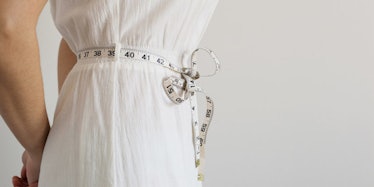
I'm Society's Definition Of Plus-Size, But I Still Don't Agree With It
The average size of a woman falls between a size 12 and 14. The average size of a fashion model falls between a size 0 and 00. The average size of a plus-size model falls between a size 6 and 14. I'm a size 16 or 18. Clearly, I'm no fashion model, and it seems I'm no plus-size model, either.
I've never shied away from the fact I'm a bigger woman. I cannot deny that I have curves. The junk in my trunk is obvious. I've been fat-shamed, and I've been fetishized. I've been told, "Real men like curves, and only dogs like bones," and I have found myself wondering, "What is a fake man?" and "Why do I really care?"
As I fluctuated from my size 10 high school body to my post-university size 18 body, I saw it all. And I have a real problem with it.
In high school, I looked at the models gracing the covers of magazines and couldn't identify with them. Today, I look at the models gracing the advertisements for "plus-sized" clothing labels, and I still can't identify with them. These are the models society proudly encourages me to embrace because I am "finally seeing my body type in the media." But, it's not my body.
When I first heard of Amy Schumer's reaction to being in Glamour's first ever plus-size issue, I was cheering. I love Amy Schumer, but her body is not mine. Her body isn't even the average, technically speaking. I am so excited to see her recognize that and to call Glamour out on it.
Because I proudly embrace my body and don't hesitate to call myself beautiful, my friends expect me to be excited over conversations such as Glamour's plus-size issue or Ashley Graham's Sports Illustrated cover. But, I'm not. These are great achievements, but they shouldn't have to be. In fact, I still find them to be dangerously limiting.
When I first began shopping at "plus-size" stores, I was really uncomfortable. At first, I thought it was because I felt shame in having gained so much weight that I was now pigeonholed into the "plus-size" category. But after walking inside, I quickly realized that wasn't the case.
I wasn't ashamed of myself at all. I felt like I didn't belong. Just like H&M or Forever 21, Torrid and Lane Bryant didn't feel like they were made for me, either. These stores, which I figured would be an escape from the pressure of achieving "thinness," still only showed me a select ideal of what it means to be a bigger woman in this world, an ideal I just couldn't identify with.
Rather than looking at their models and feeling discouraged because I was heavier than them, I looked at their models and became frustrated with how I was bigger than them. I mainly carry my weight in my legs and arms, yet these models all have wonderfully skinny, toned arms with calves that can fit into "plus-sized skinny jeans."
Their knee-high boots zipped up easily, which is an achievement I constantly struggle with. Though I had begun to feel comfortable with my weight, I suddenly was angry with where my fat decided to sit on my body. I felt as though my body still wasn't enough. I then sat at home, outside the fashion environment, and realized how ridiculous that was.
So, I don't identify as "plus-size." I choose not to adhere to the world's insane need to categorize and label bodies. Biology just doesn't work in a way that allows society to be divided among petite, average or plus.
We need to move past dividing ourselves into categories when it comes to how our bodies are shaped. In fact, we always should have been celebrating the beauty in how diverse bodies can be. That celebration is far overdue.
I am a woman. I have a body. My body does what it's supposed to do. There's no other body exactly like it. So, why should I be expected to fit neatly into a label?